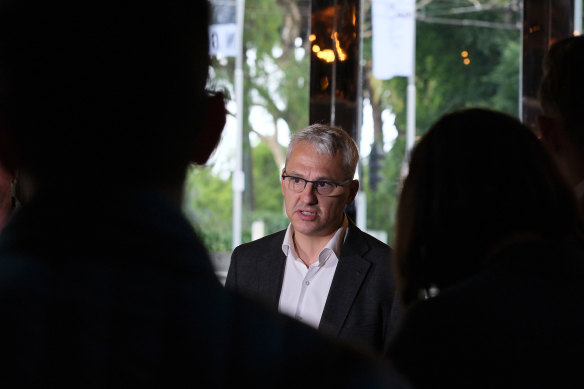This was published 1 year ago
WorkCover scheme ‘fundamentally broken’, Victorian government says
Cuts to WorkCover benefits and increases to premiums are both under consideration as the Andrews government scrambles to fix the scheme that compensates the state’s workers and pull it back to a sustainable financial footing.
Two years after launching a review of the scheme, the government has now declared WorkCover is unworkable in its current form and flagged the possibility of higher premiums for businesses four months after the state election.

WorkSafe Minister Danny Pearson. Credit: Luis Enrique Ascui
“The WorkCover scheme is fundamentally broken,” a government spokesperson said.
“The scheme is no longer fit for purpose and does not meet the modern needs of those it was originally designed to assist more than 30 years ago.”
The government would now work with business and worker organisations to look at “all options and take urgent action to continue the ongoing sustainability of the program”.
WorkSafe manages workers’ compensation in Victoria and is the trading name of the Victorian WorkCover Authority.
The body recorded an insurance operations deficit of $1.6 billion last financial year after a deficit of $3.9 billion the previous year.
Payouts exceeded premium revenue by $1.1 billion last year.
WorkSafe’s net profit after tax was $43 million last financial year. However, that figure emerged after the government announced a $300 million emergency payment in May 2022.
The state has spent more than $1 billion propping up WorkSafe over the past two years.
Government modelling predicts the scheme would need more than $1 billion a year in support from the budget if action was not taken.
Liberal MP David Davis has described the government’s emergency payments to WorkSafe as budget “landmines”.
The number of active WorkCover claims past the 130-week mark has almost doubled since June 2016, according to government figures. The scheme has not paid a dividend to the state since 2016.
WorkCover premiums have also not moved from an average of 1.27 per cent of payroll since the 2015 financial year. Victoria’s premiums are lower than all states and territories, except for Queensland.
Victorian Trades Hall Council secretary Luke Hilakari said it was time for businesses to pay higher premiums.
“We have some of the lowest contributions from businesses, as a percentage, of any state or territory. That’s a major problem,” he said.
“But we want to make sure workers’ support is maintained. And we want clever ways to intervene early to get them back to work. Mental health claims are on the rise, so we need a really well-functioning scheme.”
Government sources said it was unlikely that increased premiums would solve the scheme’s long-term sustainability issues.
Victorian Chamber of Commerce and Industry chief executive Paul Guerra said he would negotiate with the government in good faith.
“The Victorian chamber recognises that the current WorkCover system is not sustainable and adjustments need to be made to ensure its viability,” Guerra said.
“While we’d like to see additional costs to businesses minimised, we recognise that the ongoing viability of the system is paramount.”
The Morning Edition newsletter is our guide to the day’s most important and interesting stories, analysis and insights. Sign up here.